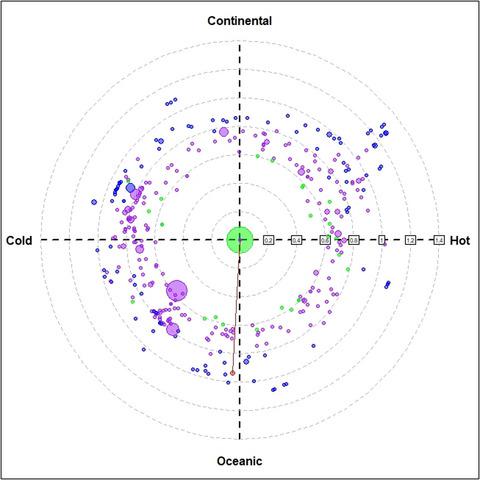Our official English website, www.x-mol.net, welcomes your
feedback! (Note: you will need to create a separate account there.)
Plant translocations in Europe and the Mediterranean: Geographical and climatic directions and distances from source to host sites
Journal of Ecology ( IF 5.3 ) Pub Date : 2021-02-07 , DOI: 10.1111/1365-2745.13609 Mohamed Diallo 1 , Sébastien Ollier 1 , Anaël Mayeur 1 , Juan Fernandez‐Manjarres 1 , Alfredo García‐Fernández 2 , José María Iriondo 2 , Anne‐Charlotte Vaissière 1 , Bruno Colas 1
中文翻译:

欧洲和地中海的植物易位:地理和气候方向以及从来源到寄主地点的距离
更新日期:2021-02-07
Journal of Ecology ( IF 5.3 ) Pub Date : 2021-02-07 , DOI: 10.1111/1365-2745.13609 Mohamed Diallo 1 , Sébastien Ollier 1 , Anaël Mayeur 1 , Juan Fernandez‐Manjarres 1 , Alfredo García‐Fernández 2 , José María Iriondo 2 , Anne‐Charlotte Vaissière 1 , Bruno Colas 1
Affiliation

|
- Although the number of plant translocations has been rapidly increasing for two decades, no study is available to date that examines the directions and distances of plant displacements, which is essential (though not sufficient) information for considering translocations as a management tool to enable species to cope with the consequences of climate change.
- In this paper, we study the geographical and climatic directions and distances from source to host sites in 638 source-and-host site pairs of plant translocations that aimed to achieve viable populations in the last decades in the Western Palearctic (Europe and the Mediterranean). Translocation distances ranged from 0 to 661 km, but were generally short, most (82%) being <25 km, due to both ecological considerations and legal and administrative constraints. The host sites were not preferentially located in any geographical direction or in any altitude relative to the source sites. In contrast, on a climate compass constructed from a principal component analysis of seven bioclimatic variables, the host sites were slightly, but significantly, under colder climatic conditions than the source sites.
- This observation appears more to be the consequence of an effort to counteract already felt effects of climate change than to anticipate future changes. The climatic distance between source sites and actual host sites was generally smaller than between source sites and randomly selected host sites at a given distance or within a given geographical area, which may be the result of a desire to minimise climatic differences or differences in other ecological factors correlated with climatic differences.
- Synthesis. This study is the first to compare, geographically and climatically, the source sites of biological material and the host sites in translocations of wild plant species to obtain viable populations. Past translocations in the Western Palearctic are in line with mitigating the consequences of global warming on plant species because the host sites were in slightly cooler conditions than the source sites. Despite this, climate considerations seem to have little been taken into account in plant translocation projects and will certainly have to be much more so in a future with rapid anthropogenic climate change.
中文翻译:

欧洲和地中海的植物易位:地理和气候方向以及从来源到寄主地点的距离
- 尽管植物易位的数量在过去的 20 年里一直在迅速增加,但迄今为止还没有研究可以检查植物位移的方向和距离,这是将易位作为一种管理工具使物种能够应对气候变化的后果。
- 在本文中,我们研究了 638 个源-宿主位点对植物易位的地理和气候方向以及从源到宿主位点的距离,旨在在过去几十年中在西古北区(欧洲和地中海)实现可行的种群. 由于生态考虑以及法律和行政限制,易位距离范围从 0 到 661 公里,但通常较短,大多数 (82%) 小于 25 公里。宿主站点不优先位于任何地理方向或相对于源站点的任何高度。相比之下,在根据七个生物气候变量的主成分分析构建的气候指南针上,宿主站点在比源站点更冷的气候条件下略有但显着。
- 这一观察结果似乎更多是为了抵消气候变化已经感受到的影响,而不是预测未来的变化。源站点与实际宿主站点之间的气候距离通常小于源站点与给定距离或特定地理区域内随机选择的宿主站点之间的气候距离,这可能是希望尽量减少气候差异或其他生态系统差异的结果。与气候差异相关的因素。
- 合成。这项研究首次在地理和气候上比较了生物材料的来源地点和野生植物物种易位的寄主地点,以获得可行的种群。过去在西古北区的易位与减轻全球变暖对植物物种的影响是一致的,因为寄主地点的条件比源地点略冷。尽管如此,在植物易地项目中似乎很少考虑气候因素,而且在人为气候变化迅速的未来肯定会更多地考虑气候因素。











































 京公网安备 11010802027423号
京公网安备 11010802027423号